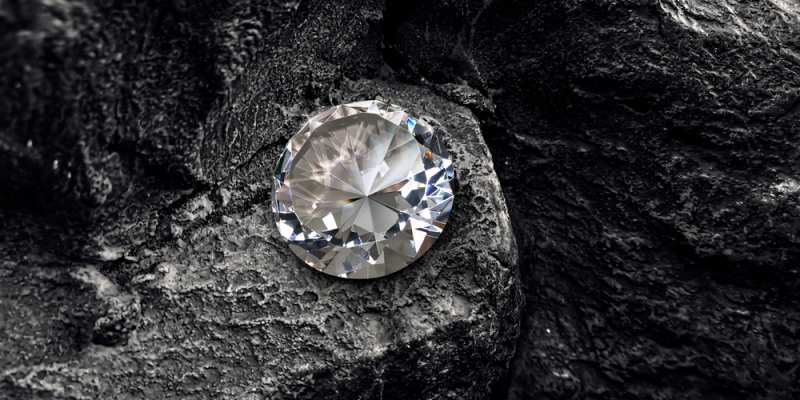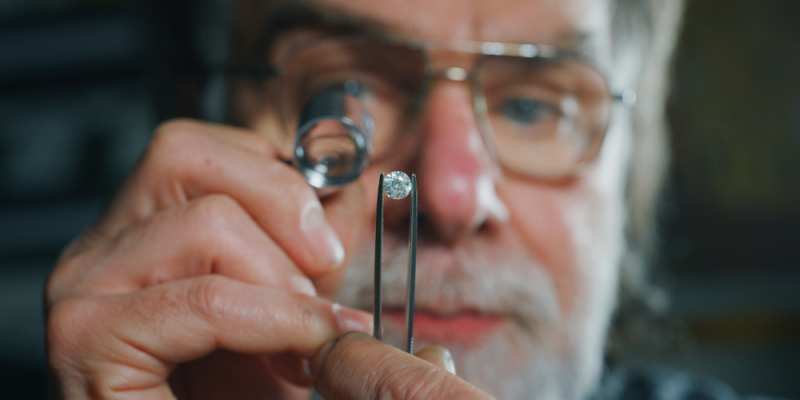It may come as a surprise to some, but diamonds can indeed be crushed under the right conditions of concentrated pressure.
While diamonds are renowned as the hardest naturally occurring material on Earth, it is important to note that hardness does not equate to indestructibility. This misconception has led many to believe that diamonds are impervious to damage. To shed light on this misconception, let’s address a simple question: Can diamonds be crushed?
The truth is that all diamonds, regardless of their size and toughness, can be crushed under certain circumstances. This raises questions about the validity of diamonds being referred to as the hardest natural material. How is it possible to crush diamonds? How do diamonds typically undergo crushing, and is it possible for a person to crush a diamond with their bare hands?
Surprisingly, every diamond possesses a weak point somewhere within its structure. Understanding the nature of this weak point and its location can provide insights into the process of crushing diamonds. If you are intrigued by the concept of diamond crushing, we encourage you to delve deeper into this topic.
DESIGN YOUR OWN ENGAGEMENT RING: START WITH A SETTING OR START WITH A DIAMOND. IT’S REALLY UP TO YOU!

Diamonds Are Extremely Durable!
To assess the value of something, we must first examine its level of rarity.
It is widely acknowledged that diamonds hold a significant price tag in the open market. Regardless of how diligently one searches for a cheap diamond, it is highly unlikely to find one priced below $2000. In fact, if such a diamond is discovered, it is advisable to exercise caution, as there may be underlying issues with the stone. Requesting a certificate from the jeweler, complete with a photograph and relevant information, is recommended. Without a certificate, it becomes challenging to ascertain the diamond’s origin.
Illicit diamond trafficking is prevalent in today’s world, so one must remain vigilant when contemplating the purchase of diamonds. Nonetheless, the high cost of diamonds can be attributed to several factors: their rarity, durability, and captivating aesthetic appeal.
Diamonds possess an unparalleled ability to emit a distinct radiance, whether under the brightest sunlight or in the darkest night. This unique light cannot be replicated by any other substance. As a result, diamonds hold immense allure and are in high demand in today’s market.
Indeed, diamonds have become an irresistible part of our lives, and for many individuals, it is inconceivable to go a day without adorning oneself with these precious gems, particularly in the form of jewelry.
The price of diamonds is further propelled by their combination of rarity and durability. While delving extensively into their rarity may not be necessary, it is crucial to dispel the common misconception surrounding the notion of diamond “durability.”
Many still believe that diamonds are virtually indestructible, mythical substances that cannot be shattered into smaller fragments. This belief persisted due to the lack of tools and technology in the past that could generate sufficient force to crush these precious stones.
However, with the invention of the hydraulic press, a new perspective emerged. People realized that while it was indeed possible to crush a diamond, it necessitated advanced knowledge and considerable strength. The hydraulic press revolutionized our understanding of diamond durability.
Therefore, while diamonds are highly valued for their exceptional qualities, it is essential to recognize that they are not invincible and can be subject to controlled conditions that result in their destruction.

Nothing Can Withstand The Mighty Hydraulic Press
The potential force generated by a hydraulic press, depending on its technological advancements, can indeed be sufficient to crush a diamond into small fragments.
Now, one might wonder, why would anyone want to crush a diamond using a hydraulic press?
Often, individuals come up with such ideas to test the real-time outcome of a particular scenario. In this case, using a diamond as a test subject can serve as an indicator of the hydraulic press’s effectiveness.
While only a few hydraulic presses may be incapable of crushing a diamond, most modern models are equipped to accomplish this task efficiently.
Consider one of the latest hydraulic press models: To generate the required force for crushing a diamond, they need to be large and robust. Manipulating them is generally straightforward, often requiring just a single button press to activate.
Once the hydraulic press is activated, a diamond can be placed between the press plates. It is advisable to use a one-carat diamond, as anything larger would be excessive and yield no additional benefit to the final outcome.
Furthermore, it is worth noting that diamond prices increase significantly with weight. For reference, a one-carat diamond weighs a mere 0.2 grams. The aforementioned diamond prices we discussed earlier were based on one-carat diamonds.
Quite expensive, wouldn’t you agree?
Jokes aside, a one-carat diamond is more than sufficient to assess the performance capability of high-end hydraulic presses.
However, on a serious note, it is crucial to prioritize safety when handling a hydraulic press and diamonds. Protective gloves and goggles are essential before placing a diamond under the press. Soon, you’ll understand why these precautions are necessary.
Typically, a hydraulic press will feature only a few buttons. When attempting to crush diamonds, the most critical buttons will be the power button and the switch controlling the press’s overall movement.
When positioning the diamond, it is important to ensure that it remains stationary. We will discuss later why the diamond’s proper placement is essential. For now, simply positioning the diamond between the press plates will suffice. Start the machine and gradually lower the upper part of the press.
As it makes contact with the diamond, the descent rate will slow down. However, after several seconds, the press will exert enough force to crush the diamond into small fragments, continuing its descent until fully reaching the lower part of the press.
During this process, tiny diamond particles may scatter across the room, emphasizing the need for protective gloves and goggles. If even the tiniest speck of diamond dust comes into contact with our eyes, immediate medical attention may be required.
Crushing diamonds is not a common practice. Most people will rarely, if ever, have the opportunity to witness such an event online or in person. Nevertheless, there are alternative tests that can be performed to assess the performance capability of a hydraulic press.

Are There Other Ways To Crush A Diamond?
To gain a deeper understanding of diamond crushing, let’s examine the meaning of the term “crush.”
As a verb, to crush a diamond refers to applying sufficient force while pressing the precious stone between two objects, resulting in a partial or complete alteration of the diamond’s structure and appearance.
However, as a noun, to crush a diamond involves subjecting it to any form of pressure through a violent collision with another object.
One common method to achieve the first definition is by placing a diamond under a hydraulic press, which can completely crush the diamond beyond restoration.
Are there other means of crushing a diamond by applying pressure?
The first thought that comes to mind is attempting to crush a diamond with bare hands.
Unfortunately—or fortunately—natural diamonds cannot be crushed with bare hands. Human strength alone is incapable of generating enough force to crush a diamond.
However, when considering the noun form of “crush,” the situation changes. While we may possess enough strength to crush a diamond, we require other objects to aid in the destruction of the diamond, breaking it into small pieces.
This is where a steel hammer becomes useful.
It is important to note that not all hammers are suitable; only steel hammers are capable of achieving this task. No matter how hard one tries, it is impossible to crush a natural diamond with a wooden or plastic hammer.
To crush a natural diamond, a steel hammer must be used, coupled with the generation of sufficient force.
Only then, with a swift and forceful swing, can a diamond be crushed by striking it with a steel hammer.
If you desire further information, we can provide assistance. Simply click on the link here, and you will discover comprehensive details about crushing diamonds with a hammer!

Cleavage Patterns Of A Diamond
As mentioned previously, when it comes to crushing a diamond, it is crucial to position it correctly.
How can you determine if a diamond is properly positioned before attempting to crush it?
Typically, you won’t be able to confirm the correct placement of a diamond until you actually attempt to crush it. However, if you have access to a microscope, it can aid you in getting closer to achieving your goal.
What are cleavage patterns?
Diamonds possess four cleavage directions, which refer to specific angles at which the diamond crystalizes. This might be the first time you’ve encountered this concept.
But for now, there’s no need to be overly concerned about it.
The essential point to remember is that striking or applying pressure directly on one of the diamond’s cleavage patterns will result in a destructive, crushing effect on the diamond.
Consider these cleavage patterns as the most vulnerable points of a diamond.
In both organic and inorganic entities, weaknesses or vulnerable spots exist. Diamonds are no exception to this rule.
In the human body, we have arteries that, when damaged, can lead to severe health problems. Similarly, diamonds possess cleavage patterns that serve as weak points.
By striking or applying pressure to one of these weak spots, you can successfully crush the diamond, albeit with less resistance and more finesse.
Therefore, the next time you find yourself contemplating crushing a diamond—for whatever reason—remember to identify its cleavage patterns. Some can be observed with the naked eye, but most will require the use of a high-tech microscope.
Here’s an important reminder: There have been instances where individuals unfortunately experienced the crushing of their diamonds. Accidental impact on a weak spot of the diamond resulted in it being crushed into small pieces.
Why does this happen?
If a diamond is struck directly on one of its weak points, regardless of whether you are aware of cleavage patterns, the diamond can be crushed. Therefore, it is essential to handle your diamonds with care at all times.
While diamonds are undoubtedly durable, they may not be as impervious as you might assume!

Summary
“Diamonds are forever” is a phrase that you’ve likely heard numerous times in your life, and we couldn’t agree more with its sentiment. However, there are instances where that “forever” may not hold true. If a diamond is accidentally struck in the right—or rather, wrong—spot, you may find yourself in need of a new diamond sooner than expected.
In today’s world, the internet is filled with both valuable and worthless information. While exploring various sources, we noticed a lack of substantial information regarding whether diamonds can be crushed or not. We hope that we have been able to provide you with some answers.
As it is now evident, all diamonds can be crushed, particularly if you possess knowledge about their cleavage patterns. However, if you are not well-versed in the weak points of diamonds, there is no need to fret excessively. By ensuring that your diamonds are kept safe from harm, you can have your sparkling companion for a lifetime.
On the other hand, if you subject a diamond to a hydraulic press, it is essentially a farewell. No diamond can withstand the immense pressure exerted by a state-of-the-art hydraulic press.
Indeed, diamonds are crushable, and sometimes, it only takes a small amount of pressure to achieve that!


